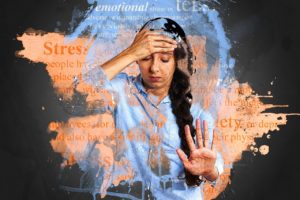 I’ve recently been hearing more and more about an “epidemic” of anxiety in all segments of the population in the United States. It makes sense, and is certainly reflected in my psychotherapy practice. Anxiety, after all, is primarily about fear. Fear is rampant right now as we face great uncertainty about how we will bring everything back together to some semblance of normalcy after the pandemic. Fear can also be contagious so its no wonder that many of us “pick up” on it through our friends and through the “news” and social media. The good news is that, although anxiety can be crippling, it is also very treatable. Its useful first, I think, to look at how anxiety manifests in our daily lives. See if you recognize yourself, and then I’ll have some tips for self-treatment.
I’ve recently been hearing more and more about an “epidemic” of anxiety in all segments of the population in the United States. It makes sense, and is certainly reflected in my psychotherapy practice. Anxiety, after all, is primarily about fear. Fear is rampant right now as we face great uncertainty about how we will bring everything back together to some semblance of normalcy after the pandemic. Fear can also be contagious so its no wonder that many of us “pick up” on it through our friends and through the “news” and social media. The good news is that, although anxiety can be crippling, it is also very treatable. Its useful first, I think, to look at how anxiety manifests in our daily lives. See if you recognize yourself, and then I’ll have some tips for self-treatment.
How does anxiety present itself?
A very common manifestation of anxiety is excessive “worry”. People “worry” about small things like weather they will like a new haircut, and they worry about big things like weather they will still have a job to support a family. A hallmark of worry is that it is often about things that have not even happened yet, so our minds go “crazy” imagining what “might” happen. We “catastrophise about the worst possible outcome and convince ourselves that this “worst case scenario” will occur.
I’m describing Generalized Anxiety here.
Anxiety is felt in the body
If you are a “worrier”, you will know that when we “worry” we experience a certain kind of “fluttering” in our heartbeat, or just a sick kind of nausea in our stomach. Along with this, we may feel lightheaded and we may have “sweaty” palms. This is the body response to “perceived” danger. The key here is “perceived”. In reality, we are most likely not “in danger”, but our body thinks we are.
Anxiety can “ramp up” into a“panic” that does not subside. It can get worse
This happens when we begin to feel an “anxiety” attack coming on and we “freak out” with fear because we can’t “stop” it. We actually make our panic worse by having “anxiety about our anxiety”…or “fear of the fear” if that makes sense
Anxiety can bring on specific fears…such as the fear of leaving home
I’ve noticed with the advent of “shelter in place” that some of my more generally “fearful” clients are now feeling unsafe about leaving home. I get it. First we are told to “stay at home” and be safe. Now we have to figure out when and under what circumstances it might be ok to mix and mingle and be social again. Its not so easy .and sometimes it feels safer to stay at home. Fear of leaving home is a form of agoraphobia and there is an uptick of this of late.
So…what can we do about our anxiety?
Here are some steps to consider:
Become aware of and learn to accept that you have anxiety
Perhaps paradoxically, an impediment to getting relief from anxiety symptoms is to admit freely to yourself and others that you have difficulty with anxiety. This refers back to what I was saying about “anxiety about the anxiety”, so that when you “worry” about your anxiety you are adding another layer to the anxiety itself. Instead try accepting that you are feeling some anxiety, and try to be curious about where it might come from. Also, have compassion for yourself. Tell yourself its ok not to feel ok.
Try to alleviate the symptoms through deep breathing and progressive relaxation and meditation techniques
Anxiety is felt in the body, so part of the treatment needs to address the body’s stress response. This can be done through the technique of progressive relaxation, as well as beginning a mindfulness meditation practice. YouTube is full of both of these “relaxation” techniques
Begin To Examine and question your thoughts for “cognitive distortions”
The best “evidence based” technique for changing the negative and catastrophic thoughts we think…(that is the thoughts that cause us anxiety)…is called cognitive behavioral therapy. Many self-help books are available to help you look at your automatic negative thoughts, and find ways to replace negative thoughts with positive ones.
Begin To do The things that you have been avoiding
Anxiety manifests often with a behavioral component, For example, if you are afraid of leaving home, you begin to restrict yourself to staying at or near home. If you are afraid to be around people, you will start avoiding them. You may find that even the thought of leaving home and socializing brings feelings of anxiety. Guess what? The only answer is to “test out” your hypothesis that leaving home is dangerous, by actually taking a brief excursion outside your home. If you do this slowly and carefully, you can prove to yourself it’s perfectly safe. This method is called “exposure” and it works well for specific fears.
I hope these tips have been helpful, and you can begin to tackle anxiety symptoms through your body (meditation and relaxation), your mind (changing negative thoughts) and your behavior (doing the “scary thing”)
